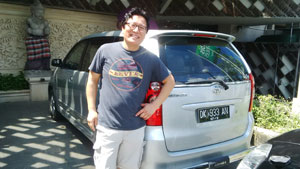Bali Architecture is Amazing
20 August 2012Gates are tall, meru (mountain)-shaped walls, shrines walls puppet-size buildings, and people live mostly in the open with drawing into the intimacy of their small rooms only for the length of the night. The Balinese base their traditional architecture on the Hindu theory of balance among Man, God and Nature. Man seen as “Bhwana Alit’ (microcosm or Small World), is expected to insert himself into his natural environment in a way which conforms to the order of the “Bhwana Agung” (macrocosm or large World).
According to the “ Asta Kosala Kosali” manuscripts all architecture structures should thus reproduce the tripartite order of both the world and the human body. Every building and compound should have a head , a body and a lower body genitalia, bowels and legs), corresponding to the gods, humans and demons. The large, open Balinese temple have thus an inner sanctum, where the main puppet-sized shrine are located , a middle yard for dances and “human-level” ceremonies and a lower yard where the kitchen is located and where relatively impure rituals suck as cock fighting take place. Similarly in the individual family compounds, the family temple is the head of the building while its body consists of the living quarters and the kitchen and lavatory are its bowels and genitalia respectively.
 Stone carvings are also integrated into the architecture of temples, building and houses. Temple walls and statues depict demons and deities, as well as Dutch colonialists and scenes of drunken parties , car breakdowns and even a bike rider. The carving son gateways are more elaborate as they are the borders that isolate the inner world from the outer world. Today, Bali is no longer an agrarian society. Tourism is bringing in twice as much as agriculture and the population is relocating to the coastal areas and long the main roads, upsetting the old agrarian patterns. Tourism itself is eating up ever larger chucks of the island. The consequences can be easily guessed, land is too scarce to allow for the preservation on the old harmony. Attempts have been made to answer the challenge. The principle of cosmic harmony between Man, Nature and God has been made the semi-official ideology of the island (under the name of Tri Hita Karana, the three causes of happiness). Regarding tourism development policy, the regional government has tried with some success to enforce “design specification” reflecting the Balinese concept of architecture . The construction permits of the hotels in Nusa Dua Resort have thus all been delivered under the scrutiny of the a design committee and on the condition that they display the tripartite structure.Joke aside, this Balinese concern with harmony has undoubtedly contributed to the creation of a genuinely modem, yet “indigenous “type of tourism architecture.
Stone carvings are also integrated into the architecture of temples, building and houses. Temple walls and statues depict demons and deities, as well as Dutch colonialists and scenes of drunken parties , car breakdowns and even a bike rider. The carving son gateways are more elaborate as they are the borders that isolate the inner world from the outer world. Today, Bali is no longer an agrarian society. Tourism is bringing in twice as much as agriculture and the population is relocating to the coastal areas and long the main roads, upsetting the old agrarian patterns. Tourism itself is eating up ever larger chucks of the island. The consequences can be easily guessed, land is too scarce to allow for the preservation on the old harmony. Attempts have been made to answer the challenge. The principle of cosmic harmony between Man, Nature and God has been made the semi-official ideology of the island (under the name of Tri Hita Karana, the three causes of happiness). Regarding tourism development policy, the regional government has tried with some success to enforce “design specification” reflecting the Balinese concept of architecture . The construction permits of the hotels in Nusa Dua Resort have thus all been delivered under the scrutiny of the a design committee and on the condition that they display the tripartite structure.Joke aside, this Balinese concern with harmony has undoubtedly contributed to the creation of a genuinely modem, yet “indigenous “type of tourism architecture.
Most of the hotels of Nusa Dua will go down in history as landmarks of post-traditional architecture. More affluent now, The Balinese pull down old building to replace them with new ones whenever they can. Instead of the airy traditional family compound with its central yard and open living quarters under verandahs, more often than not there are now cramped rows of buildings of an indefinable style. Things are all worse with large structures. When the Balinese repair temples gates and village halls, they often pull down invaluable architectural treasures and replace them with similar concrete structures. The tripartite structures might have been kept intact and thus be in accordance with the vaunted “Tri Hita Karana”, but the damage is done. The main obstacles to the conservation of the ‘Tri Hita Karana” ideology ignore conservation but it also tends to soothe the minds of the Balinese. Being repeatedly told, mantra-like that their culture is based on the principle of harmony, many Balinese refuse to even consider that this harmony is threatened. Very few are really aware of the need to preserve their architecture heritage.
Accustomed to seeing themselves through the eyes of others (the tourists) they often insist on the observation of dance, which is going to change, which is going to change any way, but pay little attention to architecture, which normally has a much longer life-span. Other obstacles to architectural conservation are social houses are privately owned and temples are owned and rules collectively by congregations whole members like the cheap statues and shrines of Gianyar Style because they are official. Furthermore, they feel they own their temples and that no one should interfere. Imposing a conservation policy on the these groups is risky and requires time. When, for example, the Indonesia government and UNESCO tried several years ago to protect “MotherTemple” of Besakih ,most Balinese protested as they saw it as a threat to their religious liberties . A good intention was misunderstood, perhaps for lack of Information.
Bali Best Quote
Why rent a car in Bali?
- Bali Car Rental Self drive with wide range of well maintained fleet
- Rent a car with Bali tour driver
- Bali Car charter, price already included car, Bali tour driver and petrol. Our tour driver will be happy to drive for you as per your own itinerary in Bali Island.


| For mor information please feel free to contact Rent Car Bali.net | |
| Hotline | local 085737187321 |
| overseas: +62 85737187321 | |
| 6285737187321 | |















